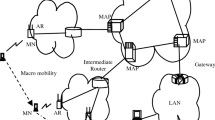Abstract
The second generation of WiMAX solutions, based on IEEE 802.16-2005 standard, offers limited mobility support. Unfortunately, after quickly changing the point of attachment on the WiMAX data link layer (DLL), very slow and inefficient IPv6 reconfiguration takes place. Delays introduced by automatic configuration (DHCPv6 and IPv6 protocols) and Mobile IPv6 can easily diminish or even render useless all benefits gained using the efficient handover performed on DLL. As handover is a crucial process in mobile cellular environments, reasons behind delays introduced by IPv6 layer mechanisms have to be analyzed and appropriate countermeasures applied.
In order to analyse influence of different factors on the handover delay a simulation environment modelling the full handover procedure in a WiMAX environment has been developed. It allows simulation and analysis of various mobility related issues, offering support for multiple base stations with groups of subscribers, both fixed and mobile, with various mobility models. Also support for tight integration with higher layers (IPv6, DHCPv6, and Mobile IPv6) is fully implemented. All stages of full IPv6 handover in IEEE 802.16 environment, focusing on major reasons of reconfiguration delays are described.
The paper presents components, functional requirements and architecture of the simulation environment, together with example simulation results. The obtained results clearly show that most significant delays are caused by the IPv6 layer. The areas of improvement in several autoconfiguration mechanisms are identified. Proposals include novel use of DHCPv6 relays for remote configuration, solving DAD delays, limiting Binding Update procedure in Mobile IPv6, and configuring routing through DHCPv6 communication.
A universal metric for assessing impact of every stage on handover efficiency is also defined. Several proposed improvements to the IPv6 handover process are evaluated. Discussion regarding possible generalization of best improvement proposals and remarks on further research areas conclude this paper.
Similar content being viewed by others
References
IEEE working group (2004). IEEE 802.16-2004: IEEE standard for local and metropolitan area networks—part 16: air interface for fixed broadband wireless access systems, IEEE, Oct. 2004.
IEEE working group (2005). IEEE 802.16-2004: IEEE standard for local and metropolitan area networks—part 16: air interface for fixed and mobile broadband wireless access systems, IEEE, Dec. 2005.
Deering, S., & Hinden, R. (1998). Internet protocol, version 6 (IPv6) specification, RFC2460, IEEE, Dec. 1998.
Narten, T., Nordmark, E., & Simpson, W. (1998). Neighbor discovery for IP version 6 (IPv6), RFC2461, IETF, Dec. 1998.
Thomson, S., & Narten, T. (1998). IPv6 stateless address autoconfiguration, RFC2462, IETF, Dec. 1998.
Droms, R. (2003). Ed. dynamic host configuration protocol for IPv6 (DHCPv6), RFC3315, IETF, Jul. 2003.
Johnson, D., Perkins, C., & Arkko, J. (2004). Mobility support in IPv6, RFC3775, IETF, Jun. 2004.
Mrugalski, T. (2008). Dibber—a portable DHCPv6, project homepage, http://klub.com.pl/dhcpv6/, Nov. 2008.
Mrugalski, T. (2008). Numbat—mobile IPv6 in WiMAX environment, project homepage, http://klub.com.pl/projects/numbat/, Nov. 2008.
Kraus, M. (2003). DOD: transition to IPv6, http://www.usipv6.com/2003arlington/presents/Marilyn Kraus.pdf, Dec. 2003.
WiMAX Forum (2006). Mobile WiMAX—part II: a comparative analysis, http://www.intel.com/netcomms/technologies/wimax/mobile wimax p2.pdf, Apr. 2006.
Tae Lee, K. (2007). Create the future with Mobile WiMAX, Communications Magazine, May 2007.
Wozniak, J., Nowicki, K., & Mrugalski, T. (2004). Mobile users issues, in micro and macro scale, in IP networks, SIS2004, Lodz, Sep. 2004.
Wikipedia (2007). IPv4 address exhaustion, http://en.wikipedia.org/wiki/IPv4addressexhaustion, Aug. 2007.
Wozniak, J., & Mrugalski, T. (2007). Numbat—extensible simulation environment for mobile, IPv6 capable IEEE 802.16 stations, ATNAC’2007, Christchurch, NZ, December 2007.
Wozniak, J., & Mrugalski, T. (2008). How to improve the efficiency of IPv6 handovers in IEEE 802.16 networks, ATNAC’2008, Adelaide, Dec. 2008.
IEEE 802.21 working group, http://www.ieee802.org/21/.
Author information
Authors and Affiliations
Corresponding author
Rights and permissions
About this article
Cite this article
Mrugalski, T., Wozniak, J. Analysis of IPv6 handovers in IEEE 802.16 environment. Telecommun Syst 45, 191–204 (2010). https://doi.org/10.1007/s11235-009-9244-z
Published:
Issue Date:
DOI: https://doi.org/10.1007/s11235-009-9244-z




